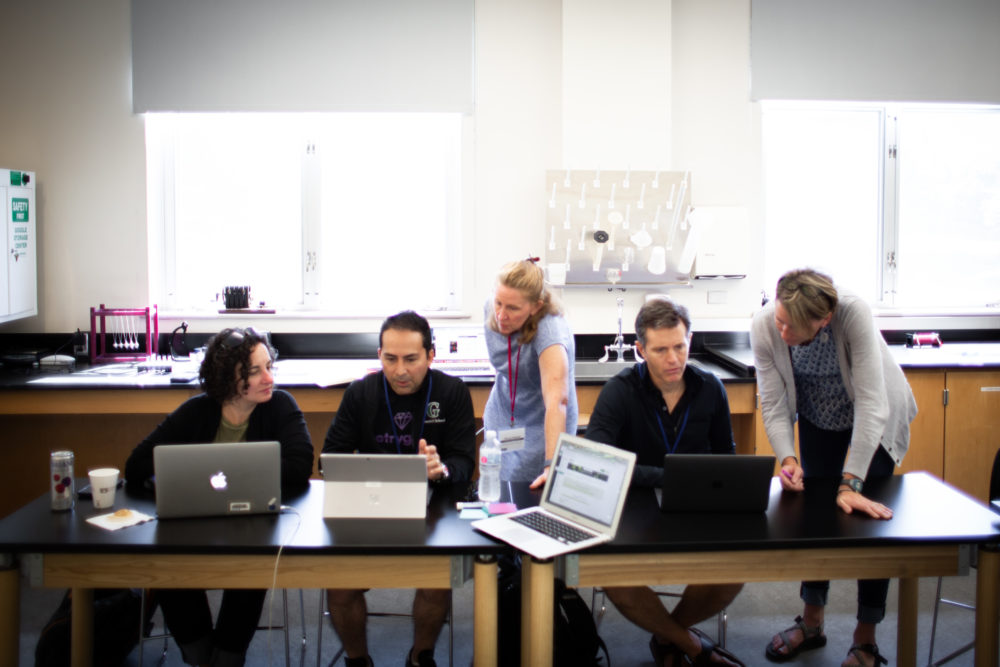20 Predictions for Education in 2020
There is a lot happening right now in education! Since my last set of predictions for 2019, schools have made significant strides in launching initiatives that are strategically focused on student and teacher learning. Schools are seeing themselves more as communities of learning for everyone rather than just a place students go to learn. Figuring out our relationship with colleges and universities, using grades more effectively, leveling up our faculty, and creating immersive learning environments are some of the big ideas we’re hearing about consistently from school leaders and educators.
20 Predictions for 2020
1. Dual Credit Programs
Dual credit programs, where high school students can earn college credit, are growing at a significant rate. There are also an increasing number of BA/MA programs where students can earn both degrees in five or six years. Combine these two ideas — dual credit and dual degree — and we may see more colleges get into the high school arena, or maybe even high schools get into the college space.
2. Embedded Experiential Learning
This was on my list last year and is making the list again. We have seen many schools launch J, X and Winter terms as a way not just to solve scheduling challenges, but to actually get students off campus and into the world. We’re going to see more and more schools move beyond the mini-term model and bring experiential learning into the regular course experience. We'll see schools become increasingly dynamic in how they use time, space, and locale in interdisciplinary, experiential learning: more flex terms, modular courses, capstone projects, etc. And, we'll see more students become partners in designing those experiences. These real world learning experiences will extend the classroom learning experience well beyond field trips and site visits. They will take students into their communities to solve real problems.
3. Relationships-Based Online Learning
Online learning began similarly to X-terms: many teachers tried to wedge the idea as a discrete activity into their classrooms and called it flipped classroom (which, for the record, is not what online learning is about!). Realizing now that online spaces are places students and educators can connect deeply with one another (or even outside experts), teachers and schools are viewing online education as a way to achieve their learning goals and even school missions. The question, finally, is not, “Should we?” but, “How do we?”
4. Educator Competencies
Last year I wrote about competency-based professional learning, and this year we’re going to see a focus on one component of that: educator competencies. We’ve been working with schools on implementing competency-based learning (CBL) into their student programs, which is highlighting the need to clearly define the skills and mindsets teachers need to do that work well. With that, we can design great learning experiences for educators, but we can also communicate what kind of learning environment we want our schools to be for students and adults.
5. Personalized Professional Learning
Once those educator competencies are clearly defined, we’re going to see more and more personalized learning pathways for adults. This differs from the way many schools currently offer professional learning, which is leaving it to educators to find and participate in their own learning experiences, perhaps via a conference, school visit, etc. Personalized learning pathways for adults means that their learning experiences are tied to learning objectives, they are ongoing and job-embedded, and they are borne from clearly defined educator competencies. This is not laissez-faire learning; it’s targeted, measured, and deliberate professional growth.
6. Shifting from “Innovation” to “Strategy”
For years we saw schools create positions focused on innovation, which drove the creation of some great programs within schools. This year we are going to see something similar in the area of strategy. Along with the head of school, who positionally is the Chief Strategy Officer, schools will focus less on innovation and more on the implementation of strategy. Strategy is less about launching new initiatives and more about making valuable initiatives stick. The National Association of Independent Schools (NAIS) is leading a lot of this work via their Strategy Labs, which aim to help small school teams “make strategic progress”.
7. Wellness as Human Resource
Last year I wrote about creating wellness spaces, and while we’ll continue to see schools designing spaces that foster positive mental well-being, we’re going to see more and more schools invest in people to ensure that wellness isn’t just something that happens in a single place, but that it is a central part of our curriculum. The role of Director of Wellness will become increasingly common.
8. Middle Schools as Innovation Hubs
Middle schools will be hotbeds of innovation, especially in schools where students don’t need to apply to a separate high school. Elementary schools are models of project-based, hands-on learning, but middle schools can be seen as training grounds for high schools, where students are introduced to tests, grades, and note-taking, and less learning by doing. Just as high schools are asking themselves who drives what they teach (Is the college admission process driving the curriculum?), middle schools will find they have the freedom to be incredibly creative with their programs.
9. Flexible Teaching Schedules
In some cities, it's an increasing challenge to find affordable housing near the school where educators work. In some cases, teachers must travel hours to reach campus. Add to that the large numbers of teachers retiring or wanting to retire, plus independent schools losing educators who can make significantly more in their local public school system, and something needs to change. Companies around the world see remote working as a major benefit for employees, and schools will soon follow suit. Rather than come to campus five days a week, teachers could be there two or three, with the rest of the week focused on collaborative projects, student internships, online learning, or experiential learning.
10. School Partnerships
The creativity, energy, and desire to build that the people in our schools possess is both a blessing and a curse. It’s a blessing because our students reap the rewards of all that is created, but a curse in that we often replicate work that is being done well in other schools, or continue to add more and more to what we’re already offering. Our schools need to partner with each other more than they are. By partnering to offer programs or to drive change, we will all be able to offer better work with fewer resources.
11. Distance Learning Makes a Comeback
Distance learning has been around for a long time, from correspondence courses to MOOCs to relationship-based learning platforms. For a number of reasons, including the cost of flying people places and the knowledge that learning is about the application of, and feedback on, new ideas, not just exposure to them, organizations need to offer learning opportunities that meet people where they are (literally and figuratively). Online learning is a an incredibly useful tool for this work, and this year we will see more and more organizations and programs articulate and deliver online learning strategies and initiatives.
12. Ending the Grading Zero-Sum Game
The to grade or not to grade debate is a false choice that will be corrected this year. We will see educators have important conversations about equity in grading and the body of research on effective grading. Last year I wrote about a centering of the pendulum, and this is part of that: the questions we need to tackle are more nuanced than whether to grade or not. We need to learn, talk about, and reflect on what we grade, how (often) we grade it, and how we avoid the toxic elements of grades and focus on learning and growth.
13. Nimbleness as Strength
Against the backdrop of immediacy that the on-demand services available to us create, the slow evolution schools are known for will serve us less and less. Design thinking, minimum viable products (MVP’s), and deploying ideas as a way to discover their value will become an expectation of faculty, millennial parents and guardians, and our students.
14. Using Empathy to Set Policy
Perspective taking is an essential skills for modern learning, for adults as much as for students. Shadowing students will allow us to deeply understand what we’re asking of them. From homework, to sports, to clubs, to other extracurriculars, our students are doing too much. There needs to be a right-sizing to what we’re asking, and it will begin with proactive work on developing empathy and understanding of the people and communities we serve.
15. Social Emotional Literacy
Social Emotional Literacy will be the new language taught in elementary and middle schools. Ensuring students understand the vocabulary and contextual usage of social emotional learning (SEL) will help to create strong foundational skills that students will rely on for the rest of their lives. Often left as an “unspoken curriculum” that we hope gets transferred to students, SEL will become an intentional, explicit part of curriculum.

16. Networked Professional Communities
In education, it can be a challenge to find an online learning community where you can truly learn and share. We’re going to see meaningful, relationships-based education communities — similar to those surfacing in the business world and other fields — where there is an honest, open exchange of ideas and perspectives that is safe and encouraging.
17. Data Privacy
Now that schools are learning how to better use their data, understanding how to keep it private is becoming a more pressing question schools need to address. GDPR forced many companies to think deeply about data privacy and security, but now non-European Union schools need to catch up.
18. Prioritizing Research and Development
Other industries allocate significant portions of their revenue on Research and Development (R&D), but what about schools? And what does Learning R&D mean? Schools are recognizing that professional learning is their R&D, and they will allocate the necessary resources to adequately support the training educators need so that our programs continue to meet the evolving and growing needs of learners.
19. Intentionality and Transparency
One of the big trends we’ve seen over the past few years centers around articulating and measuring learning outcomes. Schools are increasingly deliberate about defining expectations and goals for both students and educators. To make sure we’re not just talking about what we want our programs to become, schools hold themselves accountable by putting our ideas into action. We can’t just say that we live our mission; we need to see it in action.
20. Badges and Credentials
There are many organizations and places that recognize skill-based learning via badging and credentialing: Girl Scouts, video games, and many learning organizations. It’s getting easier to add badges to ones’ LinkedIn page, and with a continued decentralization of where educators are leveling up, the question of how you take your credentials with you from one school to another, from one state to another, or even internationally is increasingly important to address. We will see a growing body of badged credentials offered by organizations and schools.
How are these trends on the rise or already being implemented at your school? What trends do you see on the horizon at your school, or within the educational community? Share with us on Twitter or contact us. We are passionate about supporting schools and learning organizations in pursuing this work: explore the many ways to get involved with our community.


